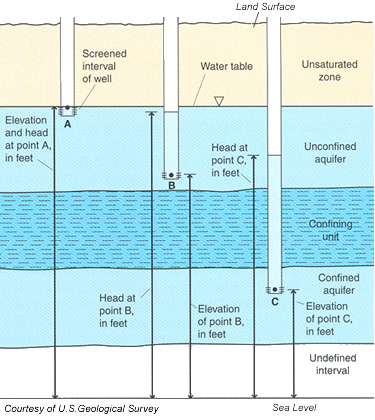GROUNDWATER BASICS - Hydraulic Head
“Hydraulic head,” or simply “head,” is the mechanical energy per unit weight of groundwater. Groundwater flows from positions of high hydraulic head to positions of lower head. The rate of flow is proportional to the rate at which head decreases with distance along the path from high head to low.
The head at a particular point in an aquifer is given by the elevation of the point above an arbitrary datum (usually sea level) plus the height to which water will rise in a vertical pipe or well whose lower end is open or screened at the point and whose upper end is open to the atmosphere. In other words, the head at a point in an aquifer is equal to the elevation of the water surface in a well which is open or screened at the point.
In this figure, the head in the unconfined aquifer at point A is simply the elevation or altitude of the water table. The head at point B, which is near the bottom of the unconfined aquifer, is the elevation of the water level in the well screened at point B. The head at point C in the confined aquifer is equal to the elevation of the water level in the well which is screened at point C.
Notice that the head at point C in the confined aquifer is above the top of the confined aquifer. This condition is characteristic of a confined aquifer. If the head were above the ground surface, the well at point C would flow freely at the ground surface and the well would be called a flowing artesian well.
Notice also that hydraulic head decreases with elevation (i.e. head at A > head at B > head at C). Since groundwater flows from high head to low, it appears in this case that the flow of groundwater is downward in the unconfined aquifer and confining bed to the confined aquifer. Such a condition could be created by pumping from the confined aquifer.
Groundwater flows toward a well when it is pumped. Why does this occur? When a well is pumped, the water level in the well is reduced so that the hydraulic head of the water in the well (given by the elevation of the water surface in the well) is less than the hydraulic head in the surrounding aquifer. Because groundwater flows from high head to low head, flow is induced in the aquifer toward the well. The rate at which flow enters the well increases as the difference between the head in the well and the head in the surrounding aquifer increases. Usually the water level in the well will approximately stabilize at a level where the rate of water entering the well from the surrounding aquifer is equal to the rate at which water is being removed from the well by the pump.
Last Updated: 10/15/21

